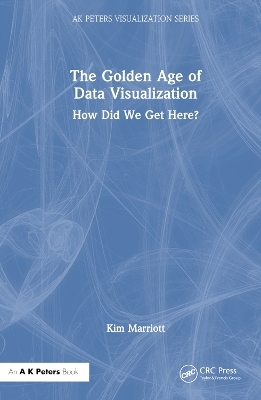
The Golden Age of Data Visualization
How Did We Get Here?
Seiten
2024
CRC Press (Verlag)
978-1-032-83079-7 (ISBN)
CRC Press (Verlag)
978-1-032-83079-7 (ISBN)
- Lieferbar (Termin unbekannt)
- Versandkostenfrei innerhalb Deutschlands
- Auch auf Rechnung
- Verfügbarkeit in der Filiale vor Ort prüfen
- Artikel merken
We are living in the Golden Age of Data Visualization. The COVID-19 pandemic has demonstrated how we increasingly use data visualizations to make sense of the world. Business analysts fill their presentations with charts, journalists use infographics to engage their readers, we rely on the dials and gauges on our household appliances, and we use mapping apps on our smartphones to find our way.
This book explains how and why this has happened. It details the evolution of information graphics, the kinds of graphics at the core of data visualization—maps, diagrams, charts, scientific and medical images—from prehistory to the present day. It explains how the cultural context, production and presentation technologies, and data availability have shaped the history of data visualization. It considers the perceptual and cognitive reasons why data visualization is so effective and explores the little-known world of tactile graphics—raised-line drawings used by people who are blind. The book also investigates the way visualization has shaped our modern world. The European Renaissance and the Scientific Revolution relied on maps and technical and scientific drawings, and graphics influence how we think about abstract concepts like time and social connection.
This book is written for data visualization researchers and professionals and anyone interested in data visualization and the way we use graphics to understand and think about the world.
This book explains how and why this has happened. It details the evolution of information graphics, the kinds of graphics at the core of data visualization—maps, diagrams, charts, scientific and medical images—from prehistory to the present day. It explains how the cultural context, production and presentation technologies, and data availability have shaped the history of data visualization. It considers the perceptual and cognitive reasons why data visualization is so effective and explores the little-known world of tactile graphics—raised-line drawings used by people who are blind. The book also investigates the way visualization has shaped our modern world. The European Renaissance and the Scientific Revolution relied on maps and technical and scientific drawings, and graphics influence how we think about abstract concepts like time and social connection.
This book is written for data visualization researchers and professionals and anyone interested in data visualization and the way we use graphics to understand and think about the world.
Kimbal Marriott is a Professor in Computer Science at Monash University, where he leads the Monash Assistive Technology and Society (MATS) Centre. His research interests include data visualization and assistive technologies for people who are blind or have low vision.
1. The Beginning. 2. The Very Beginning. 3. Drawing Buildings and Machines. 4. Drawing Nature. 5. Mapping the World. 6. Mapping the State. 7. Seeing the Unseeable. 8. Visualizing Statistics. 9. Modern Visualization. 10. The Democratization of Visualization. 11. Visualization without Vision. 12. What’s Next?
| Erscheinungsdatum | 25.07.2024 |
|---|---|
| Zusatzinfo | 17 Line drawings, color; 28 Line drawings, black and white; 101 Halftones, color; 13 Halftones, black and white; 118 Illustrations, color; 41 Illustrations, black and white |
| Verlagsort | London |
| Sprache | englisch |
| Maße | 156 x 234 mm |
| Themenwelt | Kunst / Musik / Theater ► Kunstgeschichte / Kunststile |
| ISBN-10 | 1-032-83079-4 / 1032830794 |
| ISBN-13 | 978-1-032-83079-7 / 9781032830797 |
| Zustand | Neuware |
| Haben Sie eine Frage zum Produkt? |
Mehr entdecken
aus dem Bereich
aus dem Bereich
Buch | Hardcover (2024)
S. Fischer (Verlag)
36,00 €


